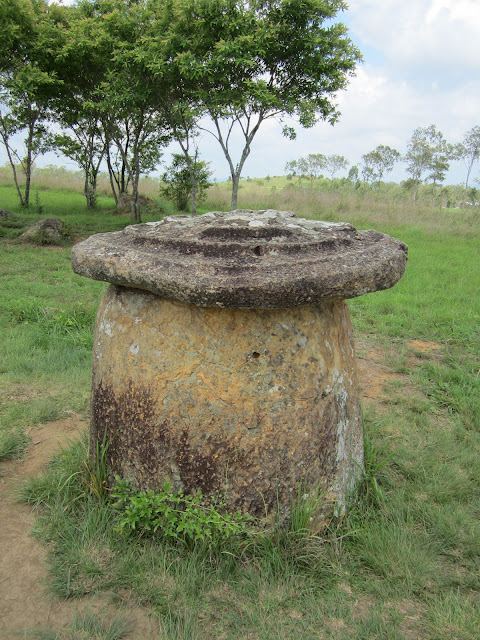The Plain of Jars is actually 80 different sites spread over the Xieng Khouang plateau in the province of the same name. The sites are collections of mysterious, megalithic sandstone jars that date back to the Iron Age. No one knows who put them there, or what they were used for. It's basically the Laotian version of the Easter Island statues.
I'm a sucker for that kind of thing. So even though Phonsavan, the city closest to the Plain of Jars, is a solid six to seven hours from Luang Prabang on sinuous mountain roads, I set out.
Phonsavan is totally charmless. But that really isn't their fault; everything there is post-1974, as almost nothing from before that date is still standing (more on that in the next blog entry). Except for the jars. And they are awesome.
On my tour I was taken to sites 1, 2, and 3, which are the most impressive. Site 1 boasts the largest jar:
Here I am for purposes of scale, with my hair looking gooood.
 |
| Want to look petite? Pose next to a six tonne piece of rock. |
They're all different sizes:
..and shapes, some round:
or egg-shaped:
Or even square:
A few have lids:
And some have been oddly, fascinatingly effected by the passage of time.
This one is the only one with a carving, which you can barely make out, but it's a sort of sketchy person shape.
Naturally, there are a number of theories as to who erected the jars and why. The popular local legend tells of a race of giants who once lived in the area, and whose king ordered the jars to be built for the brewing and storage of rice wine to celebrate a victorious battle.
Archaeologists, rather more dully, believe the jar sites to be burial monuments. The most reputable reports have recovered human remains from below and around the jars, but not inside; the jars may have held the body initially before a second burial. Or maybe they were burial urns that contained the personal belongings of the dead.
Or maybe they were used to store monsoon rain for the dry season. Or rice from times of plenty for times of famine. Or valuable salt bought from traders. Or who knows what else, really.
Site 2 occupies two hillsides, one in the forest and one overlooking the countryside. The forest site was absolutely my favorite. For some reason the jars, leaning or toppled or still upright while the trees grew around them for centuries, knocked me out.
A few trees have split some of the jars. I wish I had a time-lapse video of the seed finding a place to plant inside the ancient vessel, then slowly, so slowly, splitting it and growing around it. Outstanding.
Only a few of the jars have stone lids, but it's thought that most, if not all of them once had lids made of wood or animal skin or something that doesn't have the kind of staying power rock does. On this jar you can distinctly see the lip that led archaeologists to this conclusion:
The other area of site 2 looks over lovely countryside.
Getting to site 3 is a bit tricky. Our guide led us over a rickety bridge, then along the narrow dykes that edge the rice paddies around this site.
I thought this jar was carved, but my guide assured me that the regular striations were the result of centuries of wind and rain.
We saw a few other things on that tour, some of which I'll go into in my next post. But the best one, aside from the jars, was stopping at a hut on the terribly maintained road on the way to sites 2 and 3, where a family makes rice whisky. Here's the rice being boiled:
And then fermented for two weeks with yeast before being distilled in a barrel.
And here's the fantastic lady who makes it all, and who poured us shots of what is essentially Lao rice moonshine at 10:30 in the morning.
Of course we knocked it back. Look how happy she is; how could we not?
It was actually really good. Good enough that it made me think that the local legend of the jars might be true.
























No comments:
Post a Comment